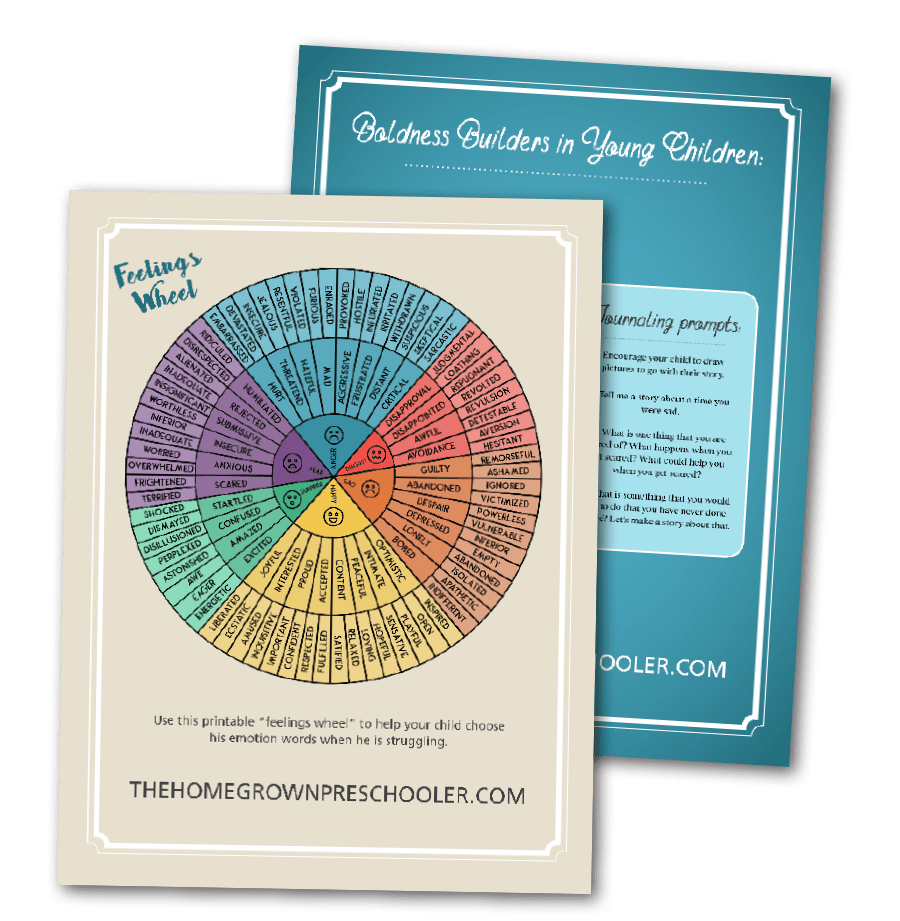

Like the young woman singing from the heart on my favorite television show, we want our children to be able to express their emotions in a bold, creative, and constructive manner. That sweet singer had a cheerleader in her father, who encouraged her emotional expression through music. As parents, and especially homeschooling parents, emotional intelligence is a crucial part of our curriculum. Our children are growing up with a host of things that make their lives more difficult than past generations, much stemming from technology that seems impossible to turn off. One thing we are glad to see, however, is that sharing emotions is encouraged, and most people agree that “children should be seen and not heard” is dangerous nonsense. Lesli’s oldest is a nurse in our local children’s hospital, and in one recent shift tended to eleven suicide attempts. She had to take one of those children, the same age as her baby sister, off life support. We must give children language to boldly express their emotions, now more than ever. Let’s start early.
1. Explore your own experiences and beliefs around feelings.
Marc Brackett, director of the Yale Center for Emotional Intelligence and a professor at the Yale Child Study Center, writes that family researchers and developmental psychologists have shown, “Parents who value emotions tend to be aware of their children’s feelings and are able to act like coaches. Parents who view emotions as harmful or disruptive are the ones who command their children to ‘suck it up’ and see their kids’ emotional expressions as manipulative. Those are the same parents who mask their own emotions and send implicit messages that feelings are unimportant.”
Do not be afraid to learn something new. The book Permission to Feel—Unlocking the Power of Emotions to Help Our Kids, Ourselves, and Our Society Thrive by Marc Brackett is a great resource.
2. Give your young child an emotional vocabulary.
There are so many kinds of sad… lonely, hopeless, grieving, disappointed, discouraged. They all have different coping skills and antidotes. Work on developing a nuanced vocabulary when you talk to your children. Research shows that parents who use more sophisticated emotional language are better at regulating their own emotions. Precise emotional language empowers your child to zero in on how to enlist help and also helps them develop empathy for others.
Use our emotions wheel to help your children identify their specific emotions and hone in on what they would like to happen next.
3. Encourage emotional expression and respond empathetically.
A child cries in anguish because they have been hit by a friend, and they are told to stop crying because it was minor. Instead of this, encourage children to tell their friend that they have been hurt, and help them negotiate a solution. Instead of simply asking the child who did the hitting to apologize, try asking the child who was hurt what he or she thinks it would take to make the situation better. Even in adulthood, it takes boldness to tell others when we have been hurt, and helping our little ones develop this skill will be so beneficial when they are older. And if they are crying, sit with them and allow them to feel. As Mr. Rogers said, “People have said, ‘Don’t cry’ to other people for years and years, and all it has ever meant is, ‘I’m too uncomfortable when you show your feelings. Don’t cry.’ I’d rather have them say, ‘Go ahead and cry. I’m here to be with you.’”
When children are terrified of the dark, this is real fear. Instead of simply telling them that there are no monsters in the closet and to stuff their emotions, acknowledge their fear. Sleeping alone can be scary, but remind them that they are courageous and brave. Remind them that you are there to check on them and keep them safe. Open the closet and show them that there are no monsters in there. Honoring their emotions of fear will build the courage in your children to be vulnerable with their emotions as adults.

4. Allow them to take risks to develop courage and confidence.
In our experience, most young children start out as brave and bold risk takers, confident and courageous. If your little ones want to take a risk and go down the slide, don’t tell them that it is too big and scary! Help them plan out a strategy and take a risk, even if it means that you go down with them! Celebrate their bravery. If your children want to express themselves in an outfit you would never put together, find something to like about it and don’t make them change!
Let’s work hard on not quieting our children’s inner voice, and teach them not to stuff their feelings. If we fail to invest the time to help our children develop the skills to be confident, bold, and brave in the early years, they will struggle to stand up for what they believe in as they grow into adults. We don’t know what the future holds for our little ones, what challenges they will endure, or what struggles they will face, However, we do know that learning to be a bold risk taker will help them deal with whatever comes their way.

Jumping in the mud puddle instead of jumping around it.
Going down a bigger slide or climbing higher than they have climbed before.
Of course you will be there to catch them and keep them safe.
Introducing themselves to a stranger and starting a conversation.
Letting your child crack the egg instead of just watching you do it.
It is okay if there are shells or it gets on the floor. It is the trying that is to be celebrated.
Saying yes as much as possible when your child asks to take risks.
Try saying why not, instead of questioning why.
Kathy and Lesli have provided journaling prompts and a “feelings wheel” to help your child choose his emotion words when he is struggling.
Download them here.





